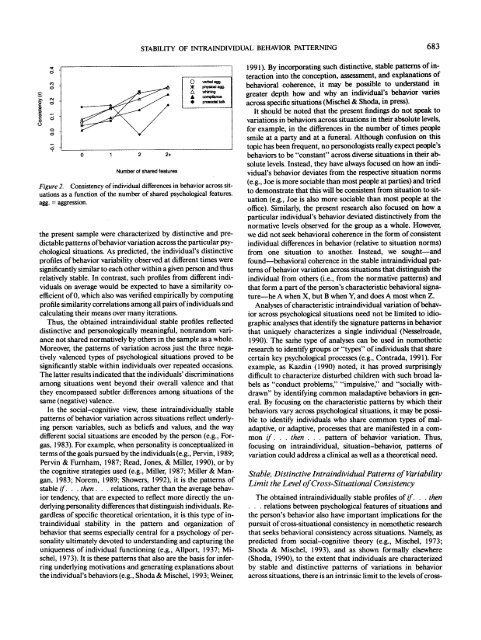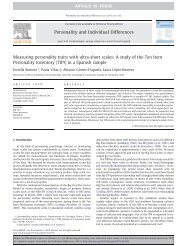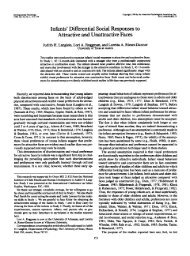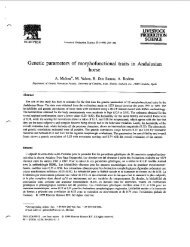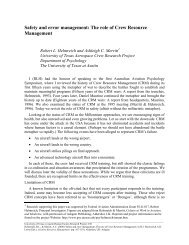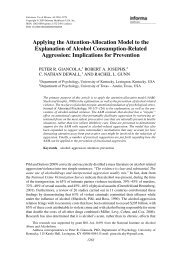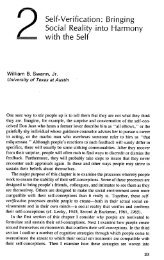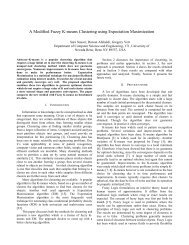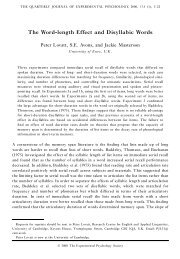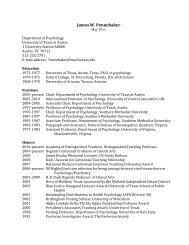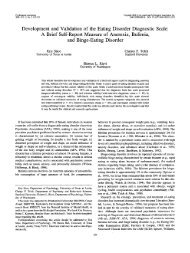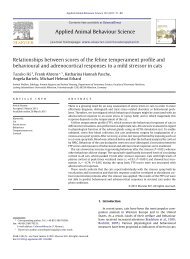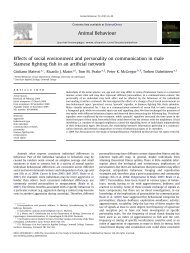PERSONALITY PROCESSES AND INDIVIDUAL DIFFERENCES ...
PERSONALITY PROCESSES AND INDIVIDUAL DIFFERENCES ...
PERSONALITY PROCESSES AND INDIVIDUAL DIFFERENCES ...
Create successful ePaper yourself
Turn your PDF publications into a flip-book with our unique Google optimized e-Paper software.
STABILITY OF INTRA<strong>INDIVIDUAL</strong> BEHAVIOR PATTERNING 683<br />
Number of shared features<br />
Figure 2. Consistency of individual differences in behavior across situations<br />
as a function of the number of shared psychological features,<br />
agg. = aggression.<br />
the present sample were characterized by distinctive and predictable<br />
patterns of behavior variation across the particular psychological<br />
situations. As predicted, the individual's distinctive<br />
profiles of behavior variability observed at different times were<br />
significantly similar to each other within a given person and thus<br />
relatively stable. In contrast, such profiles from different individuals<br />
on average would be expected to have a similarity coefficient<br />
of 0, which also was verified empirically by computing<br />
profile similarity correlations among all pairs of individuals and<br />
calculating their means over many iterations.<br />
Thus, the obtained intraindividual stable profiles reflected<br />
distinctive and personologically meaningful, nonrandom variance<br />
not shared normatively by others in the sample as a whole.<br />
Moreover, the patterns of variation across just the three negatively<br />
valenced types of psychological situations proved to be<br />
significantly stable within individuals over repeated occasions.<br />
The latter results indicated that the individuals' discriminations<br />
among situations went beyond their overall valence and that<br />
they encompassed subtler differences among situations of the<br />
same (negative) valence.<br />
In the social-cognitive view, these intraindividually stable<br />
patterns of behavior variation across situations reflect underlying<br />
person variables, such as beliefs and values, and the way<br />
different social situations are encoded by the person (e.g., Forgas,<br />
1983). For example, when personality is conceptualized in<br />
terms of the goals pursued by the individuals (e.g., Pervin, 1989;<br />
Pervin & Furnham, 1987; Read, Jones, & Miller, 1990), or by<br />
the cognitive strategies used (e.g., Miller, 1987; Miller & Mangan,<br />
1983; Norem, 1989; Showers, 1992), it is the patterns of<br />
stable //. . . then. . . relations, rather than the average behavior<br />
tendency, that are expected to reflect more directly the underlying<br />
personality differences that distinguish individuals. Regardless<br />
of specific theoretical orientation, it is this type of intraindividual<br />
stability in the pattern and organization of<br />
behavior that seems especially central for a psychology of personality<br />
ultimately devoted to understanding and capturing the<br />
uniqueness of individual functioning (e.g., Allport, 1937; Mischel,<br />
1973). It is these patterns that also are the basis for inferring<br />
underlying motivations and generating explanations about<br />
the individual's behaviors (e.g., Shoda & Mischel, 1993; Weiner,<br />
1991). By incorporating such distinctive, stable patterns of interaction<br />
into the conception, assessment, and explanations of<br />
behavioral coherence, it may be possible to understand in<br />
greater depth how and why an individual's behavior varies<br />
across specific situations (Mischel & Shoda, in press).<br />
It should be noted that the present findings do not speak to<br />
variations in behaviors across situations in their absolute levels,<br />
for example, in the differences in the number of times people<br />
smile at a party and at a funeral. Although confusion on this<br />
topic has been frequent, no personologists really expect people's<br />
behaviors to be "constant" across diverse situations in their absolute<br />
levels. Instead, they have always focused on how an individual's<br />
behavior deviates from the respective situation norms<br />
(e.g., Joe is more sociable than most people at parties) and tried<br />
to demonstrate that this will be consistent from situation to situation<br />
(e.g., Joe is also more sociable than most people at the<br />
office). Similarly, the present research also focused on how a<br />
particular individual's behavior deviated distinctively from the<br />
normative levels observed for the group as a whole. However,<br />
we did not seek behavioral coherence in the form of consistent<br />
individual differences in behavior (relative to situation norms)<br />
from one situation to another. Instead, we sought—and<br />
found—behavioral coherence in the stable intraindividual patterns<br />
of behavior variation across situations that distinguish the<br />
individual from others (i.e., from the normative patterns) and<br />
that form a part of the person's characteristic behavioral signature—he<br />
A when X, but B when Y, and does A most when Z.<br />
Analyses of characteristic intraindividual variation of behavior<br />
across psychological situations need not be limited to idiographic<br />
analyses that identify the signature patterns in behavior<br />
that uniquely characterizes a single individual (Nesselroade,<br />
1990). The same type of analyses can be used in nomothetic<br />
research to identify groups or "types" of individuals that share<br />
certain key psychological processes (e.g., Contrada, 1991). For<br />
example, as Kazdin (1990) noted, it has proved surprisingly<br />
difficult to characterize disturbed children with such broad labels<br />
as "conduct problems," "impulsive," and "socially withdrawn"<br />
by identifying common maladaptive behaviors in general.<br />
By focusing on the characteristic patterns by which their<br />
behaviors vary across psychological situations, it may be possible<br />
to identify individuals who share common types of maladaptive,<br />
or adaptive, processes that are manifested in a common<br />
if. . . then . . . pattern of behavior variation. Thus,<br />
focusing on intraindividual, situation-behavior, patterns of<br />
variation could address a clinical as well as a theoretical need.<br />
Stable, Distinctive Intraindividual Patterns of Variability<br />
Limit the Level ofCross-Situational Consistency<br />
The obtained intraindividually stable profiles of //. . . then<br />
. . . relations between psychological features of situations and<br />
the person's behavior also have important implications for the<br />
pursuit of cross-situational consistency in nomothetic research<br />
that seeks behavioral consistency across situations. Namely, as<br />
predicted from social-cognitive theory (e.g., Mischel, 1973;<br />
Shoda & Mischel, 1993), and as shown formally elsewhere<br />
(Shoda, 1990), to the extent that individuals are characterized<br />
by stable and distinctive patterns of variations in behavior<br />
across situations, there is an intrinsic limit to the levels of cross-


